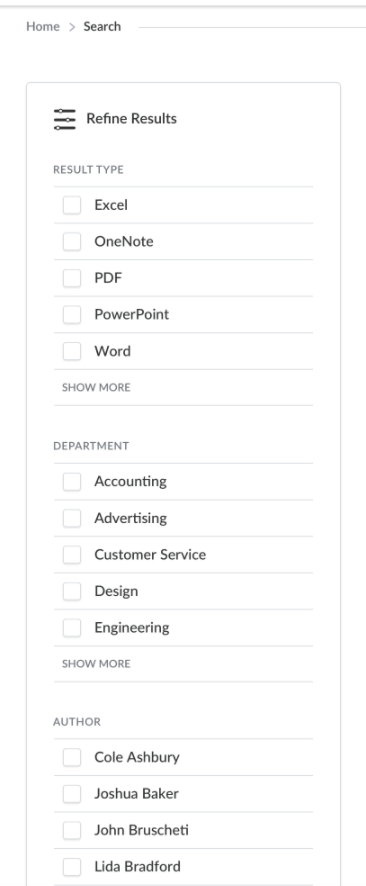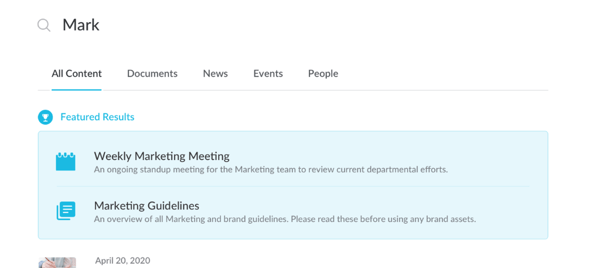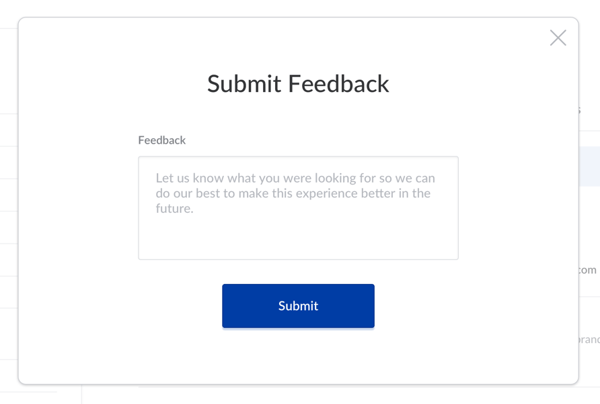Intranet search 101: Getting smart about search

Your end-users expect a stellar search experience. They've learned to love search on sites like Google, Bing, Amazon, and Zillow. Unfortunately, intranet (SharePoint or not) search experiences can leave a lot to be desired. Many users have negative feelings towards their intranet's search center and struggle to find what they need.
There is hope, however! SharePoint and IntranetPro offer many ways to enhance the search experience. In this search guide, we'll explore what you can start doing today to get more out of search!
Search Verticals
Search verticals are common in search engines, as they allow users to filter extensive search results set down to only results of a specified type. Google and Bing offer common search verticals to filter search results to show just images, videos, shopping, etc.
Out-of-the-box SharePoint Online offers four default search verticals: Everything, People, Conversations, and Videos. Additionally, Microsoft allows companies to add their own unique verticals within the Search Center.
Consider implementing search verticals that help end-users navigate to the most searched for result types as quickly as possible. For instance, IntranetPro enhances the out-of-the-box SharePoint search experience by including search verticals for Documents, News, and Events.
Search Refiners
Search refiners are an essential feature of the enterprise search experience. Like search verticals, search refiners allow users to filter extensive search result sets with a few clicks. End-users are very familiar with search refiners even if the name is new. This functionality is the basis of services like eBay, Amazon, Zillow, and Autotrader. Imagine you are searching for an iPhone case on Amazon. You might be presented with 75,000+ results when you search for "iPhone case." However, with a few clicks, you can focus your results on brown, leather iPhone 15 cases that ship in two days and are priced less than $40.
The SharePoint Online Search Center includes a few refiners from the start: Result type, author, and modified date. Additionally, organizations can add their own refiners within the Search Center to offer more granularity to end-users. A standard best practice is to coordinate custom search refiners with any organizational metadata structure used to tag intranet content.
IntranetPro builds upon the out-of-the-box SharePoint search refiners adding refiners such as "Department," allowing end-users to filter result sets down by which department uploaded a particular intranet asset.

Typeahead Search
IntranetPro type-ahead search is built to enhance the speed at which users are delivered relevant search results. This feature is prominent within every single page of the IntranetPro environment. As end-users type search terms, they are presented with immediate search results that are specifically designed based on the type of content: News, Events, Person, Page, Department, etc.

Featured/Promoted Results
Promoted intranet search results pull to the top of search the pages and data you select. These promoted results can be links, documents, videos, news, events, etc. Imagine the Human Resources department is releasing a new policy. You might build a promoted search result around the search of "New HR policy" and have the news articles just released pinned to the top of the end-users' results to see. IntranetPro includes designs for many types of promoted results. 
Search Ranking
SharePoint allows organizations to improve the search experience by customizing the search ranking models included in SharePoint. You can sort search results in SharePoint in four ways, one of which is by rank score. When you sort search results by rank score, SharePoint places the most relevant results on top in the search result set. Search results are considered relevant if they receive a high-rank score; this is a specific numeric score calculated by the SharePoint search engine using a ranking model. There are many factors used to calculate the relevance ranking, including, but not limited to:
- Query text included in the title or body of a search result
- Query text matching metadata associated with a search result
- A search result's popularity
Search Accessibility
One way to enhance your intranet's search experience is to simply make sure it is available in as many places as possible that make sense. Global search should be available on every page of your intranet site. Additionally, suppose end-users have navigated to subpages like the news center, event calendars, or document hubs. In that case, it is important to provide them with the ability to search, sort, and filter those result sets. IntranetPro includes a global search box with type-ahead capabilities and "quick search" boxes intentionally placed throughout the platform, making issues with search accessibility a think of the past.
Search Feedback
Intranet search can be one of the largest culprits of wasted time in the workforce. McKinsey reported that "employees spend 1.8 hours every day – 9.2 hours per week, on average – searching and gather information. Put another way; businesses hire five employees, but only four show up to work; the fifth is off to search for answers, but not contributing any value."
Organizations must elicit feedback from end-users on their search experience. A great way to elicit this feedback is to include a feedback mechanism on the search results page so users can let the organization know when they didn't find what they were looking for. 

Federated Search
Federated search allows end-users to retrieve both intranet content (such as news, documents, events, links, people) and information stored in other applications (SharePoint, Box, Google Drive, Salesforce, Dropbox). The intranet of today is a modern solution that is well-integrated with other applications your organization uses. Integrations help improve employee experience and productivity, but only when these integrations relate to the intranet experience. When companies use multiple cloud-based systems, it's critical to have federated search.
Search Analytics
SharePoint offers great search analytics out-of-the-box. If you have never explored the provided reports, quit reading this report and take a look now! As an administrator, you have access to the number of queries being performed in the system and the top queries by day and month. What are employees searching for the most? This can be valuable information when promoting resources through the search center.
Additionally, you can see insights around abandoned and no result queries by day and month. These reports provide information on search queries that either yielded very low click-through rates or no results at all. All of these reports give you quantitative data that can be used to make improvements.
